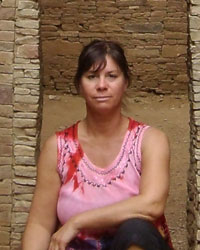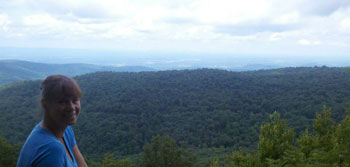D. Rae Gould, Ph.D.: Former ACHP Native American Program Specialist
 Rae Gould is a member of the Nipmuc Nation and came to the ACHP with 20 years of experience in federal acknowledgement, NAGPRA compliance, and preservation projects. In addition to serving as the THPO and repatriation representative for her tribe in Massachusetts, she most recently worked as the Repatriation Coordinator for the University of Massachusetts Amherst and has worked extensively with tribes from the Northeast, as well as conducted consultations with tribes throughout the country. She also taught archaeology, anthropology, and Native Studies courses at Connecticut College and University of Massachusetts Amherst.
Rae Gould is a member of the Nipmuc Nation and came to the ACHP with 20 years of experience in federal acknowledgement, NAGPRA compliance, and preservation projects. In addition to serving as the THPO and repatriation representative for her tribe in Massachusetts, she most recently worked as the Repatriation Coordinator for the University of Massachusetts Amherst and has worked extensively with tribes from the Northeast, as well as conducted consultations with tribes throughout the country. She also taught archaeology, anthropology, and Native Studies courses at Connecticut College and University of Massachusetts Amherst.
She has a PhD in Anthropology from the University of Connecticut, and her recent publications include: "Rethinking Colonialism: Indigenous Innovation and Colonial Inevitability" (with Stephen Mrozowksi and Heather Law) in Entangling Colonial Narratives; "Cultural Practice and Authenticity: The Search for Real Indians in New England in the 'Historical' Period" in The Death of Prehistory; and "The Nipmuc Nation, Federal Acknowledgment, and a Case of Mistaken Identity" in Recognition, Sovereignty Struggles, and Indigenous Rights in the United States: A Sourcebook. She also contributed the entry on the Native American Graves Protection and Repatriation Act in the 2013 Encyclopedia of Global Archaeology by Claire Smith.
What led you to your field?
My first formal position in the field of preservation was when I served as Tribal Historic Preservation Officer (THPO) for my tribe (Nipmuc Nation) almost 15 years ago. I have always had an interest in art, architecture, history, archaeology, and preservation. As an undergraduate I studied Art History and Architectural Studies, combined with an Anthropology/Archaeology minor, and then began working for my tribe as an archivist, researcher, and then as THPO.
How does what you do relate to historic preservation?
Working for the Advisory Council on Historic Preservation is an opportunity to be actively involved and influence issues and policy on historic preservation directly at the national level. Being in the Office of Native American Affairs also allows me to keep working with tribes from across the country on issues of historic preservation that are important to them. Helping to expand knowledge about sacred places and traditional cultural landscapes, in particular, is an important development in historic preservation right now, and something I have a background and interest in.
Why do you think historic preservation matters?
Without the ability to preserve important places on the landscape -- whether buildings from the 18th or 19th century, monuments erected to remember moments in our history, or entire landscapes used for cultural preservation and religious practices -- we would constantly be moving (and looking) forward, without adequately reflecting on our past and who we are. We study (and need to know) the past for several reasons: to understand who we are in the present and to hopefully not repeat mistakes in the future. Beyond that, though, knowing our past provides a sense of self and grounding for who we are, whether on an individual or collective basis. Without preservation of the "artifacts" of our past (whether a 5,000-year-old Native American object, the Declaration of Independence, or an important historical structure), the study and understanding of this past would not be possible.

What courses do you recommend for students interested in this field?
At the undergraduate level, courses in History, Anthropology and Archaeology, Museum Studies, Public History, and potentially Art History and Architectural History (if interests lean toward art and architecture).
At the graduate level, programs in all of these could lead toward a career in Historic Preservation, or, ideally, a graduate program in Historic Preservation itself if available.
At both levels, coursework combined with an internship would provide the best preparation. Finding an opportunity matched with your particular interests (such as art conservation, architectural restoration, archaeology, or museum curation) is ideal. Tribes may also offer opportunities to intern for their Tribal Historic Preservation Offices.
Do you have a favorite preservation project? What about it made it special?
The preservation project I feel most passionate about is the restoration of a 200-year-old homestead (the Cisco Homestead) on my tribe's reservation in Grafton, Massachusetts (the Hassanamisco Reservation). This is an important historic structure because it is one of the last (if not THE last) standing Indian Homesteads in New England dated to this period (c. 1800). I have been working on this preservation project for a number of years, and restoration of the building's exterior is underway this summer (2014), which is an exciting milestone. The property was listed on the National Register of Historic Places in 2011 and on the Preservation Massachusetts list of the state's Most Endangered Historic Resources in 2009. More information and images on the Homestead can be found at http://www.cr.nps.gov/nr/feature/indian/2011/Hassanamisco_Reservation.htm https://www.flickr.com/photos/preservationmass/sets/72157623153832552/.
Can you tell us what you are working on right now?
In addition to restoration of the Cisco Homestead, at the ACHP my responsibilities will include working on the traditional cultural landscapes action plan and developing trainings.
How do you think the national historic preservation programs help your community?
As a tribal member, I see Section 106 as probably the most critical development in historic preservation at the national level. Without the ability to be full consulting parties on projects on their lands or that affect their heritage, tribes would lose many historic and cultural resources. My tribe is state-recognized, though, and not federally recognized, so consultations are not conducted on a government-to-government basis, as they are with federally recognized tribes. We can work with neighboring federally recognized tribes on projects of interest and toward ensuring that preservation of sites and places important to us are taken into consideration. Overall, Section 106 has helped tribes across the country have a legal process to ensure their voices are at least heard when development projects threaten resources important to them.
Do you have advice for novice preservationists?
Getting involved with hands-on projects -- whether through an archaeology dig, the study and restoration of an old building, at the local historical society, or in a museum of interest -- is the best way to build experience and knowledge in preservation work. Opportunities exist in many places and at every level!
The ACHP's mission is "preserving America's heritage;" can you give us an example of how your community is preserving its heritage?
In addition to the Cisco Homestead restoration project (see above), the Nipmuc Nation has active programs for preserving and teaching the Algonquian language of our people, regalia making, beading workshops, and other educational programs so our youth can maintain knowledge of our history and culture.
How does anthropology help play a role in the preservation field?
Since the study of anthropology is, in essence, the study of human history and behavior, this has played a key role for me in my work in preservation and my focus on Native American issues. Archaeology, in particular, is one subdiscipline within anthropology that relates directly to preservation and Native American issues. Since American anthropology and archaeology were founded on the study of Native American tribes and peoples, they have a deep history and connection to Native cultures, mainly in the "preservation" of them through recordings and studies and through collecting artifacts, cultural items and human remains that have been held in museums. The relationship between anthropology and preservation is complex and, for many Native Americans, has a negative history of destructive and harmful practices. As an anthropologist and professional in the preservation world, I can see where these two fields overlap today in ways that are productive and help Native Americans be proactive in preserving their heritage. The project and the Section 106 regulations noted above provide examples of this, and training in anthropology and archaeology by more Native people has allowed them to more fully engage in the preservation field and influence the initiatives being developed, such as preservation of cultural landscapes.
Read more Q&A stories about the preservationists in your neighborhood!